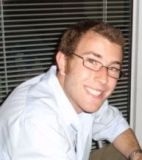Invited Talk by Dr. Raphael Sznitman
 |
Dr. Raphael Sznitman ARTORG Center for Biomedical Engineering Research, University of Bern, Switzerland
|
Finding the needle in the haystack: detection, tracking and registration in biomedical imaging
Abstract: From centimeter-sized observations visible in endoscopy to nanometer large intra-cellular structures discernible with Electron Microscopes, searching and locating objects of interest in images is a central problem in medical image computing. If anything, the need for efficient object detection techniques has never been higher due to the advent of cheaper and ever more sophisticated imaging devices, able of amassing unprecedented quantities of data. And while established search paradigms are showing their limits, faster methods capable of dealing with larger quantities of data are now indispensable. In this talk, I will present a computational framework for object detection with efficiency at its core. This framework, a Bayesian formulation of the traditional “twenty questions” game, considers a sequential strategy for evaluating different parts of the image data in order to locate the object effectively. In this context, we will see how dynamic programming and information theory can be used to characterize a provably-optimal search strategy that is both simple to compute and greedy in nature. Using these results, I will then show how this framework can be used to solve traditional object detection and tracking problems, as well as non-rigid registration of multimodal multi-scale image data, allowing for more accurate solutions and large problems to be tackled. Biography: Raphael Sznitman received his B.Sc. in cognitive science from the University of British Columbia (Canada) in 2007. Following this, he received his M.Sc and PhD? in computer science from Johns Hopkins University (USA) in 2011. From 2011 to 2014, he was a postdoctoral fellow at the École Polytechnique Fédérale de Lausanne (EPFL) in Switzerland. Since then, he is a faculty member at the University of Bern (Switzerland) where he heads the Ophthalmic Technology Lab of the ARTORG Center for Biomedical Engineering Research. His research interests lie in the fields of computer vision and machine learning with applications to biomedical imaging, surgery and histology.| WebEventForm | |
|---|---|
| Title: | Invited Talk by Dr. Raphael Sznitman |
| Date: | 9 May 2016 |
| Location: | MI 03.13.010 |
| Abstract: | Finding the needle in the haystack: detection, tracking and registration in biomedical imaging |
| Imageurl: |  |
| Type: | News |
| Videourl: | |
| Conferencelink: | |
